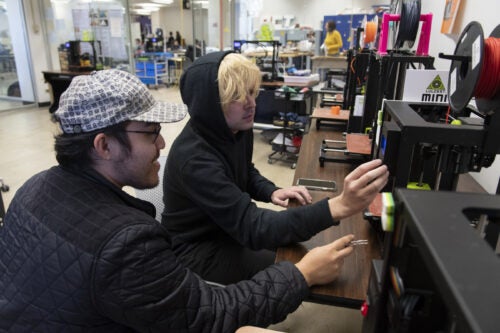
Boise State opened its MakerLab four years ago in Albertsons Library. Since then, the lab has seen an exponential growth in the number of regular users – from 23 to 1,000 per semester.
“Humans make things. Creating things, managing projects is a human essential,” said Amy Vecchione, an associate professor and head of Emerging Technologies and Experiential Learning, who runs the MakerLab.
The space – from its earliest days – was intended for “people to come together to create new knowledge,” said Vecchione. “And in order for that to happen, we had to democratize access to information.”
Boise State’s MakerLab has several three-dimensional (3D) printers. On any given day you’ll find them spinning widgets from spools of colored cord with their distinct whir and the aroma of hot plastic. You’ll also find a vinyl cutter, a desktop milling machine, cameras, microphones, a green screen, as well as sewing machines and Luddite-friendly craft items (yarn, knitting needles) for building models, or just passing the time.
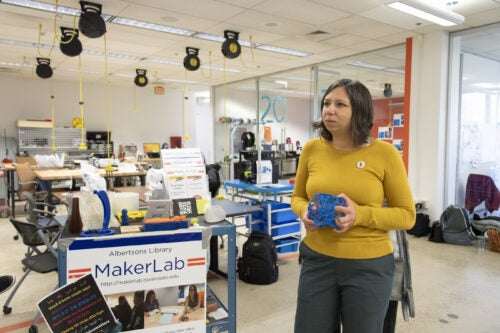
In addition to its regular users, the lab attracts numerous groups and classes. Students in Assistant Professor Brian Stone’s psychology class, Perception, Design, Accessibility, consulted with members of the blind and visually impaired community then used the MakerLab’s 3D printers to create useful objects – table brackets to hang crutches, toothbrush extenders, tactile apartment floor plans and more.
Stone called the MakerLab “an extraordinary resource,” one that provides “a sense of community and belonging.”
“I’ve had students who don’t consider themselves creative, don’t think of themselves as ‘technology people,’ and don’t identify as makers. I’ve watched as they burst out of their shell and get excited, invested and proactive about doing cool things,” said Stone. “The MakerLab provides a space where students don’t have to fear failing, but can instead use the experience of a temporary stumble to learn and grow.”
“Failure is normal here. We do it a lot,” said Vecchione.
Brennon Leman, a gaming, interactive media and mobile technology (GIMM) major and Lionel Lopez, a double major in GIMM and math, are in the Vertically Integrated Projects program in the College of Innovation and Design. Leman and Lopez are experimenting with adding scent to virtual augmented reality environments – the smell of pine for a woodland location, for example, or the smell of sulfur for Yellowstone. Both value the MakerLab for its open space and tools.
“And it’s free,” said Lopez.
Still, the MakerLab battles stereotypes. Some people assume it’s solely for students in technical fields. Others find it intimidating. Some don’t yet know it exists. Vecchione wants to dispel those ideas. She invites anyone to visit.
“Come in, pick up one of the projects sitting around, and ask, ‘How did this get made?'” said Vecchione.
A staff of maker space leads – look for the students wearing gray aprons – is ready to answer.
A week in the lab
Here’s a recent sampling of what was going on in Boise State’s MakerLab:
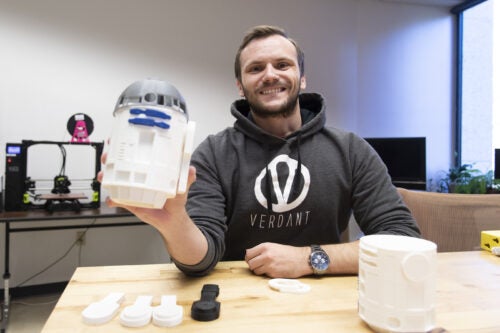
Monday: Dillon Richey, a junior majoring in computer science with a German minor, initially visited the MakerLab at the suggestion of a friend. His first project there was working on a homework assignment with fellow math students. While calculating the number of spheres in a pyramid of spheres, they covered two entire white board tables in the MakerLab with notations, he said. Richey now calls himself a MakerLab regular. He recently learned to use the sewing machines and is using the lab’s software programs and equipment to create his own spin on a model of R2-D2 of “Star Wars” fame.
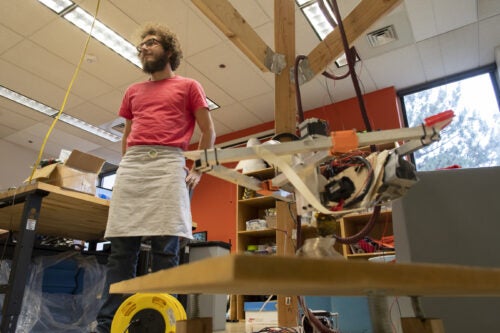
Tuesday: Chris Dagher, a second-year student in the engineering PLUS program, which adds a design curriculum built around the engineering major, is building what may be the largest 3D printer in Boise – a structure that stands well over six-feet tall. Dagher, another MakerLab regular, said he’s there late nearly every night and on the weekends – so often that the sound of the 3D printer has become restful for him. He has other projects at the MakerLab, starting a robotics business with two friends and working on a particularly timely project in the wake of Boise’s recycling changes. He’s part of a group looking for ways to transform plastic waste into jackets.
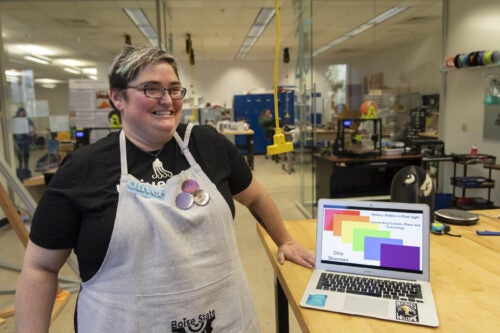
Wednesday: Ollie Shannon is a senior graduating with an anthropology degree. Shannon also is a maker space lead and assists fellow students with their projects. One created a mold for ceramic egg cartons. Another, a fine art student, turned to the MakerLab and Shannon to help make replicas of her work. Shannon’s own project in the lab is researching and designing a map app for a comprehensive walking tour of Boise’s queer history, “History Hidden in Plain Sight.”
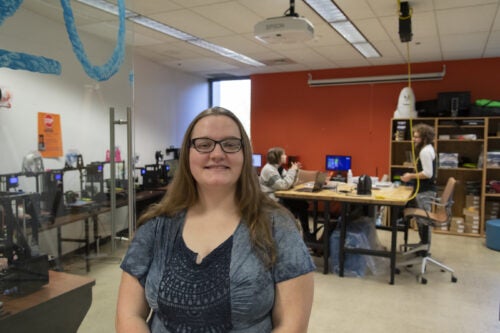
Thursday: Jen Tiedtke, a senior graduating with a double major in English education and history, fell in love with the MakerLab by falling in love with 3D printing. She still has her first project, a blue Tardis from the “Doctor Who” series. Tiedtke also created a perfect Bronco B covered with foil to adorn a float for Albertsons Library and the Creative Technologies Association.
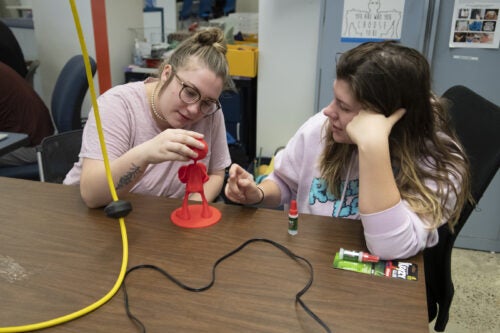
Friday: Lexie Wright, a junior majoring in GIMM and psychology, works as a MakerLab manager.
“The 3D printers are the coolest,” she said.
But through her work in the lab, she has also learned computer-aided design (CAD) programs and how to use the lab’s SLA printer, a machine that creates objects – everything from engineering parts to dental implants and jewelry – from layers of liquid resin.
“You can learn everything in this space,” said Wright. “All are welcome. We love questions, problems and projects.”